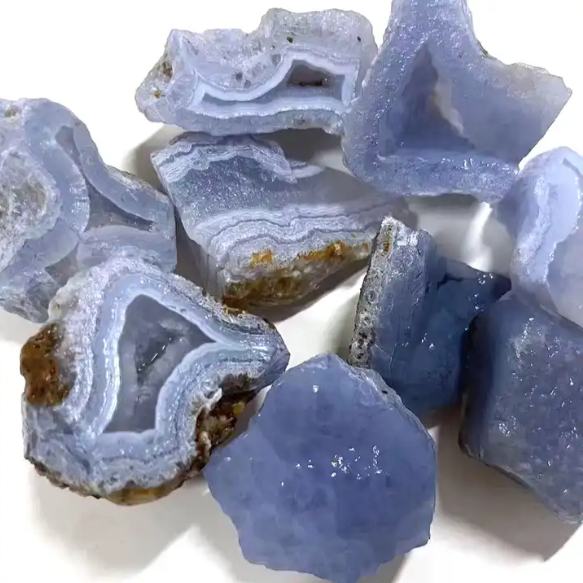Table of Contents
Agate captivates with its stunning array of patterns and hues, embodying the virtues of balance, harmony, and resilience. This remarkable stone, revered through centuries, offers a glimpse into the delicate interplay of color and form, crafted by nature’s own hand. Agate stands as a symbol of balance, harmony, and strength. Whether you’re seeking to ground your spirit, enhance creativity, or protect your energy, Agate offers a natural solution that has been cherished through the ages.
Formation
Agate formation is a natural process that occurs when silica-rich solutions infiltrate cavities within rocks. Over time, these solutions cool and evaporate, causing silica to precipitate and form microscopic crystals. The distinctive banding and patterns in agates are created as layers of silica and minerals accumulate in successive deposits. Various colors and patterns arise from the presence of trace elements and impurities in the solution. Agates solidify and harden over geological time scales, often taking thousands or millions of years. They become exposed through natural processes like erosion or volcanic activity and are prized for their beauty and used in jewelry and decorative items.
Colors
Agate comes in a wide range of hues and is known for its banded and colorful appearance. The general form of the agate is round and looks like a simple rock; only when opened can you see its beauty. The colors in agates are influenced by the presence of trace elements and impurities in the silica solution. Different elements, such as iron, manganese, and chromium, can impart various hues to the agate, resulting in the diverse range of colors and patterns seen in these beautiful gemstones.
The green, blue, pink, and purple agates are dyed.
Origin
Agate is a widespread mineral that can be found in many different parts of the world, and each location often produces agate with unique characteristics and patterns.
Some of the largest sources of agate include Brazil, Uruguay, Mexico, and the United States. In Brazil, agate is found in the state of Rio Grande do Sul, where it is known for its bright and colorful banding patterns. Uruguay is known for its amethyst and agate geodes, which are commonly used as decorative objects. Mexico is another major source of agate, particularly the Laguna Agate from the state of Chihuahua, which is known for its bright colors and unique patterns. In the United States, agate can be found in several states, including Oregon, Montana, and Arizona.
History
The name “agate” is believed to originate from the Achates River, which is now known as the Dirillo River in Sicily, Italy. Agate was first discovered along the banks of this river, and its name is thought to have been inspired by the place of its initial finding. Agate has a rich history dating back thousands of years, with various cultural and historical significance. In ancient times Agate has been used for ornamental purposes, it was highly prized by the Egyptians, who carved it into jewelry, seals, and amulets. Ancient Greeks and Romans also used agate for decorative items and cameos. In the medieval period, agate was believed to have protective and healing properties. It was often used in amulets and talismans to ward off negative energies and illnesses. In islamic and asian traditions Agate held significant cultural and spiritual importance, it was used for prayer beads, amulets, and as a symbol of protection. Nowdays, in modern times, Agate continues to be a popular choice for jewelry, including rings, necklaces, and bracelets. It’s also used in decorative items, home decor, and even in interior design for its distinctive banded patterns. Agate has also been of scientific interest due to its formation process and use in the study of mineralogy. Understanding the banding and colors in agate can reveal information about the geological history of the region in which it was found.
Spiritual Aspects
Balancing Energies: Agate have a balancing effect on the energies within the body, promoting equilibrium and harmony. It help balance yin and yang energies.
Protection: Agate is considered a protective stone, particularly against negative energies and psychic attacks. It is thought to create a shield that wards off negative influences.
Grounding: Agate is associated with grounding energy, helping individuals stay connected to the earth and remain rooted. This can be particularly helpful for those who feel scattered or uncentered.
Chakra Alignment: Agate is associated with various chakras, depending on its color. For example, blue lace agate is often linked to the throat chakra and communication, while green agate is connected to the heart chakra and emotional healing.
Meditation: Many individuals use agate as a meditation aid. It is believed to help quiet the mind, facilitate deep meditation, and enhance spiritual awareness.
Emotional Aspects
Creativity: stimulate creativity and enhance artistic abilities. It can inspire new ideas and creative expression.
- Concentration: Agate is thought to enhance mental focus, making it easier to concentrate and make decisions.
- Courage: Agate is often linked to attributes like strength and courage. It is said to boost self-confidence and enhance one’s ability to face challenges and overcome obstacles.
- Optimism: promote optimism and a positive outlook on life. It can help individuals focus on the present moment and let go of past regrets or future anxieties.
Self-Acceptance: Agate aid in self-acceptance and self-esteem. It can encourage a positive self-image and self-love.
Physical Aspects
- Digestive Health: Some people use agate to support digestive health. It is thought to help with issues like indigestion, gastritis, and upset stomach.
- Skin: Agate support healthy skin and may help alleviate skin conditions when used in crystal healing or elixirs.
- Blood Circulation: It can improve blood circulation in the body, potentially helping with issues related to poor circulation.
Types of Agate
An agate geode is a type of geological formation where agate is formed inside a hollow or cavity in a rock. Geodes are formed when mineral-rich water seeps into the hollow spaces in rocks, leaving behind mineral deposits that build up over time. When agate is formed inside these cavities, it can create a beautiful and unique pattern of banded colors and textures.
Agate geodes are often cut open to reveal the colorful banding inside. The exterior of the geode is usually a dull, rough rock surface, while the interior is filled with sparkling crystals and colorful layers of agate. Some geodes may also contain other minerals or crystals, such as quartz or amethyst.
Agate geodes are popular for their natural beauty and are often used as decorative objects. They can be displayed as a natural sculpture, used as bookends, or even cut and polished into small decorative pieces. Agate geodes are also popular in the metaphysical community, where they are believed to have healing properties and spiritual significance.

Blue lace agate is a variety of agate that is characterized by its pale blue and white banding, often with a lacy or wavy appearance.
Blue lace agate has a calming and soothing effect on the mind and emotions. It is associated with communication, self-expression, and the throat chakra, which is the energy center that governs communication and self-expression. Help with verbal and nonverbal communication, and promote self-confidence and self-expression. It is a calming stone that helps reduce stress and anxiety and promotes a sense of calmness and tranquility.
Blue lace agate is often used in meditation or placed near the throat chakra to enhance communication and self-expression. It is also used in jewelry and decorative objects and is highly valued for its soft and delicate appearance. It is found in many parts of the world, including Brazil, Uruguay, and the United States.

Crazy agate is a type of agate that is known for its vibrant colors and unique patterns. It is also sometimes referred to as “Mexican Crazy Lace Agate” or simply “Crazy Lace Agate.” Crazy agate is found in Mexico and is often used in lapidary work to create cabochons, beads, and other decorative objects.
The patterns and colors in Crazy Agate are formed through the deposition of different minerals in layers, which create a banded effect. The exact colors and patterns can vary widely, with some specimens featuring bright, contrasting colors and others displaying more muted tones. The patterns in Crazy Agate can sometimes resemble a landscape or other natural scene, which adds to its appeal as a decorative stone.
It is believed to promote stability, grounding, and balance. It helps with emotional healing and reduces stress and anxiety while also enhancing creativity and self-expression. Like other types of agate, crazy agate also offers protection against negative energies and promotes a sense of inner strength and resilience.
Eye Agate is a type of agate that has a distinctive pattern resembling an eye. The pattern typically consists of concentric rings of different colors, often with a central dot or “iris” that gives the appearance of an eye. The colors and patterns within the stone can vary widely, depending on the minerals present and how they have been deposited over time.
Eye Agate is believed to have been used in jewelry and other decorative objects for thousands of years. It has been found in ancient Egyptian tombs, and was also used by the Greeks and Romans. In more recent times, it has been used in jewelry making, particularly in cameos and intaglios.
Eye Agate is found in various locations around the world, including Brazil, India, Madagascar, Mexico, and the United States. It is formed from silica-rich fluids that have deposited minerals in cavities and fractures in volcanic rocks. As the fluids cool and crystallize, they form the distinctive patterns seen in Eye Agate. The specific minerals present in the stone can vary depending on the location and geological conditions in which it formed.
Eye Agate has several metaphysical and healing properties, which vary depending on the specific colors and patterns within the stone. Some of the common attributes associated with Eye Agate include:
Protection: offer protection against negative energy and the evil eye, which is said to be caused by envy or ill wishes from others.
Insight: The eye-like pattern in Eye Agate is said to enhance intuition and provide insight into situations or people.
Focus: help with concentration and focus, particularly in situations where distractions are present.
Balance: promote balance and harmony in life, helping to alleviate stress and anxiety.
Healing: have a calming effect on the mind and body, and may be used to help alleviate headaches, eye strain, and other physical ailments.
Fire Agate is a variety of agate that exhibits a bright, fiery orange or red color, often with white or gray banding. It is also known as “flame agate” .
Fire Agate is formed when iron oxide or other minerals are deposited within the agate, creating the vibrant coloration. The banding within the stone can create unique and intricate patterns, adding to its visual appeal.
Fire Agate has strong grounding and stabilizing properties and is associated with the root chakra. It promotes feelings of courage, strength, and vitality and helps with issues related to self-confidence and personal power.
Agate fire is often used in crystal healing to help with issues related to the digestive system as well as to support the immune system and promote overall health and well-being.
It is found in many parts of the world, including Mexico, the United States, and Brazil. It is often used in jewelry and decorative objects, and is highly valued for its striking color and unique patterns.
Iris Agate is a type of agate that displays a beautiful iridescent effect on its surface, often showing a range of colors that resemble the rainbow. The minerals in the layers can vary, which contributes to the unique patterns and colors seen in Iris Agate. The iridescent effect is created when light passes through the thin layers of minerals and is refracted and scattered, creating a rainbow-like effect. The exact process by which this iridescence is formed is still not completely understood, but it is believed to be related to the crystal structure of the minerals and the way light interacts with them.
Iris Agate is a unique and beautiful variety of agate, and it is prized by collectors and jewelry makers for its stunning display of colors. It can help with emotional healing, inner strength, and balance. Like all agates, Iris Agate is associated with the throat chakra, which is said to promote communication and self-expression.
Moss agate is a variety of agate that is characterized by its green or brownish-green moss-like inclusions or dendrites, which resemble moss or other foliage. These inclusions are typically made up of manganese or iron oxide and can create unique and intricate patterns within the stone.
Moss agate has a grounding and stabilizing effect on emotions and is associated with the heart chakra. It promotes feelings of peace, calmness, and tranquility and helps balance emotions and heal emotional wounds.
Moss agate also has physical healing properties. It is often used in crystal healing to help with digestive issues as well as to support the immune system and promote overall health and well-being.
It is found in many parts of the world, including the United States, India, Brazil, and Australia. It is often used in jewelry and decorative objects and is highly valued for its unique and intricate patterns.
Tree agate is a type of agate that is typically white or gray with green dendritic inclusions that resemble tree branches or foliage. These inclusions are formed by minerals such as manganese or iron, which create the distinctive patterns within the stone.
Tree agate is believed to have a calming and stabilizing energy, and is often used in crystal healing to promote emotional balance and physical wellness. It is also said to help with connecting to the natural world and promoting a sense of harmony with.

